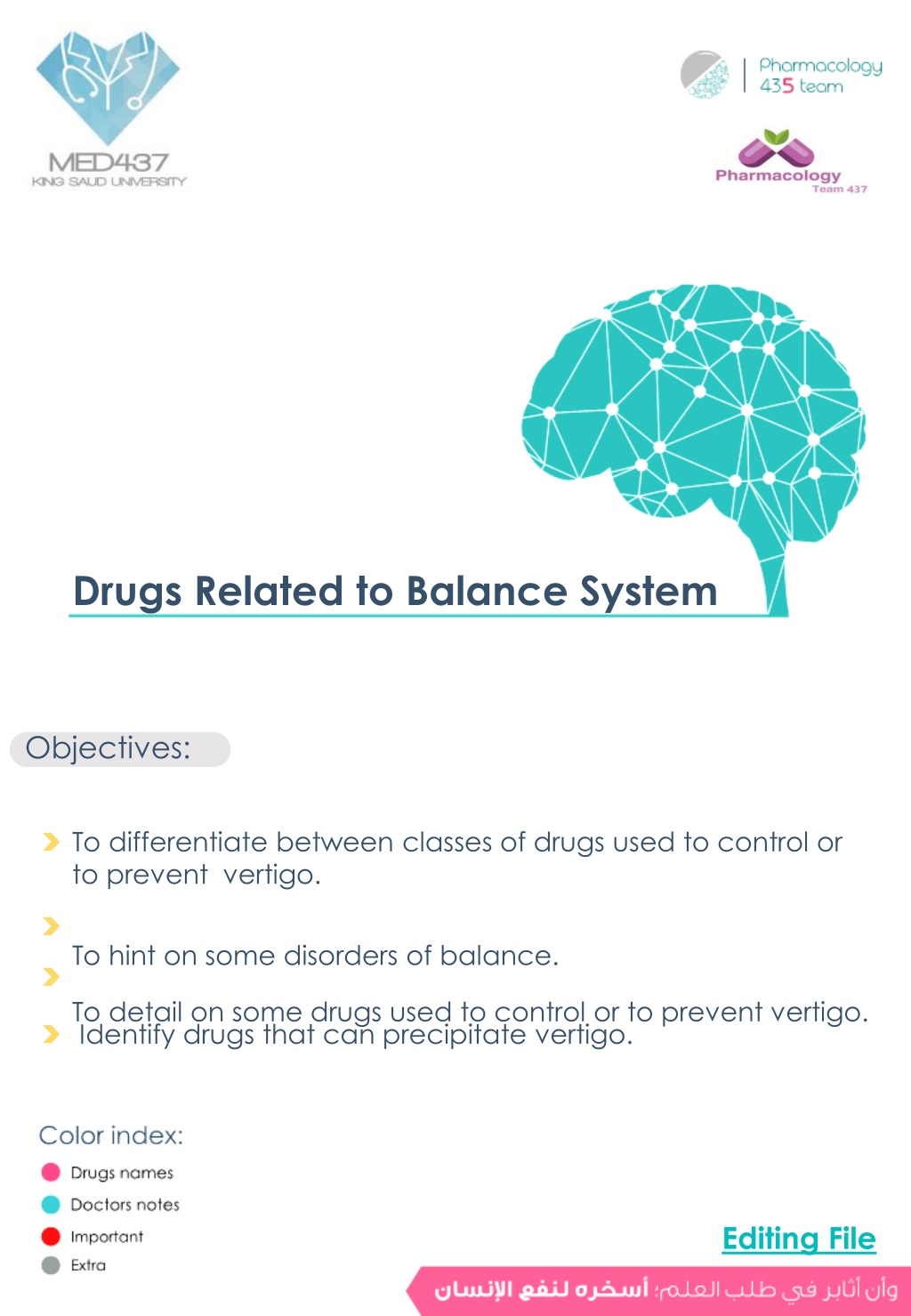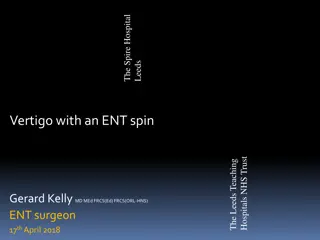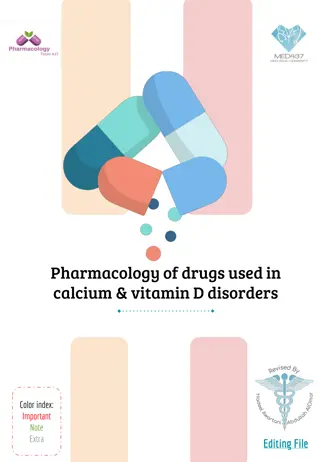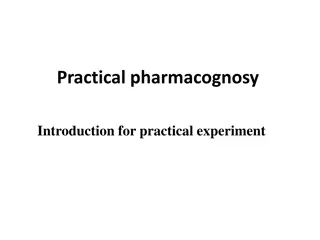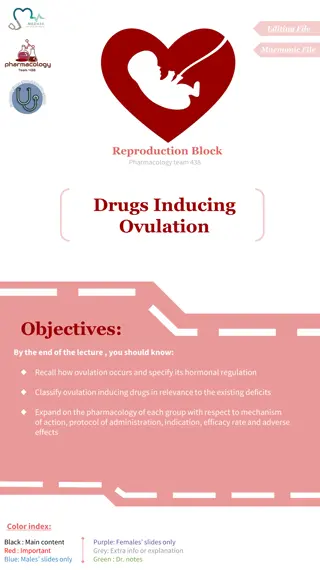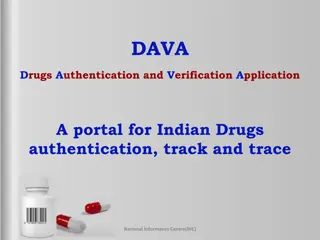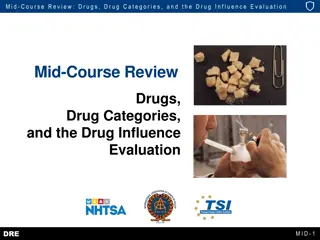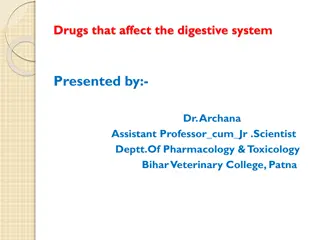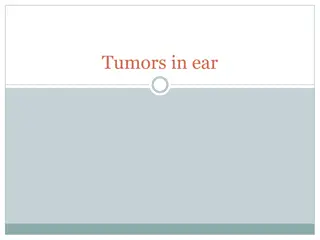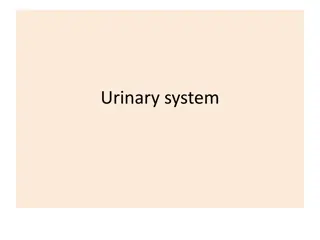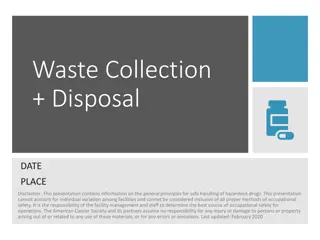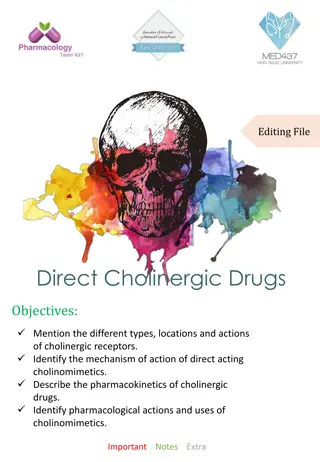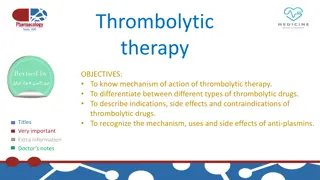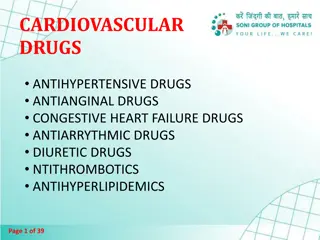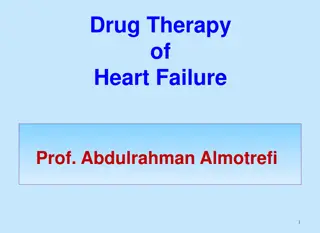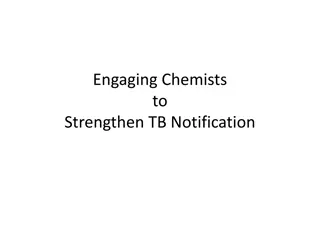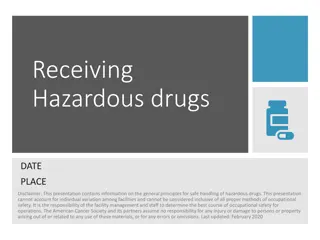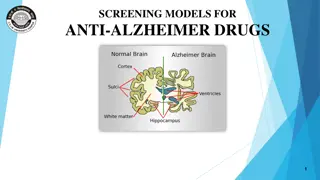Drugs Related to Balance System and Vertigo Management
Understanding the classes of drugs used to control or prevent vertigo, identifying disorders of balance, and detailing drugs used for vertigo management. Learn about drugs that can trigger vertigo and the mind map of specific treatments involving various medications.
Download Presentation

Please find below an Image/Link to download the presentation.
The content on the website is provided AS IS for your information and personal use only. It may not be sold, licensed, or shared on other websites without obtaining consent from the author. Download presentation by click this link. If you encounter any issues during the download, it is possible that the publisher has removed the file from their server.
E N D
Presentation Transcript
Drugs Related to Balance System Objectives: To differentiate between classes of drugs used to control or to prevent vertigo. To hint on some disorders of balance. To detail on some drugs used to control or to prevent vertigo. Identify drugs that can precipitate vertigo. Editing File 0
Drugs Related to Balance System Vertigo Vs Dizziness: Dizziness Vertigo -Part of dizziness, complain in change in sensation of movement only (SPINNING). Types: Objective: object is moving while the patient is stationary. Subjective: patient is moving while surrounding is stationary. - Used to express subjective patient complaints related to changes in sensation, movement, perception, or consciousness. - BALANCE DISORDER (the individual will feel unsteady when standing or walking) Symptoms - Lighted headedness: Symptom of feeling about to faint. - SPINNING(Vertigo). - Confusion or disorientation. - Falling or feeling as if one is going to fall. - Nausea or vomiting. - Sweating. - Nystagmus (Abnormal eye movement). Pathophysiology of vertigo (Extra): As we know that vestibular system is used to maintain the balance by detecting angular and linear acceleration of the head. Sensory information from the vestibular system is then used to provide a stable visual image of the retina (while the head moves) & make adjustment in posture that are necessary to maintain balance. Vertigo happens if there is abnormality in the vestibular system or CNS structures that process signals from the semicircular canals. 1
Drugs Related to Balance System Balance disorders: 1- Benign paroxysmal positional vertigo (BPPV) non fatal, happened suddenly, and triggered by head movement a change in head position causes a sudden sensation of spinning. 2- Acute labyrinthitis Inflammation of the balance apparatus of the inner ear, probably caused by a viral infection. 2:43 min 3- M ni re's disease its cause is unknown = idiopathic fluid accumulation in inner ear can cause swelling and pressure which will disturb the signaling information between inner ear and brain. This causes repeated episodes of dizziness, usually with ringing in the ear & progressive low-frequency hearing loss The symptoms of meniere s disease might be caused by dislodgement of the crystals which are formed of calcium carbonate. they re located within the margin of the three canals in the inner ear where they might enter the fluid which will cause imbalance and ringing in the ear. 2
Mind Map Drugs Related to Balance System Specific treatment Symptomatic treatment Prophylactic treatment Involves targeting the underlying cause of the Vertigo (e.g. ear infection, use Antibiotics, or inflammation with anti-inflammatory drugs) Involves controlling the acute symptoms and autonomic complaints (e.g., vertigo and vomiting) Aims to reduce the recurrence of specific vertiginous conditions. 1- Diuretics1: Except Loop diuretics.2 e.g: furosemide 2- Corticosteroids3. 3- K & Ca2+Channel Blockers4 Cinnarizine Antihistamine Antiemetics Vestibular suppressants Reduce the intensity of vertigo and nystagmus evoked by a vestibular imbalance. Used to control vomiting & nausea Mnemonic! Don t Come Close because they are prophylactics, so you don't want the symptoms to come in the first place! Don t - Diuretics Come - Corticosteroids Close - Ca2+ Channel Blockers 1- Anti-cholinergics. hyoscine 1- Antihistamines. dimenhydrinate 2- Benzodiazepines. Lorazepam, Clonzepam, Diazepam 3- Betahistine. 2- Phenothiazines. prochlorperazine 3- Dopamine antagonists. metoclopramide domperidone 3
Vestibular suppressants Anti-Cholinergics Benzodiazepines Drug Lorazepam, Clonzepam, Diazepam Betahistine Hyoscine (scopolamine) 1- Inhibit firing in vestibular nucleus neurons. - Minimize anxiety and panic associated with vertigo - It is a structural analog of histamine with: 1-Weak histamine H1 receptor agonist By stimulating H1 receptors located on BV in the inner ear local vasodilation and permeability helps to reverse the underlying problem of endolymphatic hydrops. 2- Reduce the velocity of vestibular nystagmus. Mech. of action 2-More potent histamine H3 receptor antagonist properties By blocking H3 receptors the local concentration of histamine in the inner ear. - increases the level of serotonin in the brainstem the activity of vestibular nuclei. -activation of presynaptic (H3) inhibitory action inhibit histamine release. -activation of postsynaptic(H1) excitatory action release histamine . -Betahistine will block H3 histamine release increased. Mnemonic! minimize anxiety , Dont Cry , Laugh D= Diazepam C= Clonzepam L=Lorazepam - Tablet or oral solution. - Rapidly and completely absorbed (Lipid soluble) - t = 3-4 h. excreted in urine within 24h. - Low protein binding. ____ P.K ____ -sedation - motion sickness. - In small dosages useful for the management of acute vertigo. Meniere s disease Indications Hyoscine = high = like in an airplane > motion sickness :) - used as anti depressant, anti seizure, anticonvulsants, and hypnotics how to remember that Betahistine is used for Merniere s disease? Merniere betahistine = - Dry mouth. - Blurred vision. - sedation. , vertigo - Dependence. - Impaired memory. -increased risk of falling. -Headache -Nausea. -GIT side effects. H1 agonist = cramps ADRs Mnemonic! Balance Helps Cats Leap Down - Pheochromocytoma ( Histamine is active= catecholamine= Active tumor) - Bronchial asthma. bronchoconstriction - History of peptic ulcer. H2 in stomach - Hypersensitivity reaction. Balance - Betahistine Helps - Hyoscine Cats - Clonzepam Leap - Lorazepam Down - Diazepam C.I 4
Anti-emetics ( ) Dopamine antagonists Anti-histamines Phenothiazines Drug Metoclopramide Domperidone Dimenhydrinate Prochlorperazine - Block H1 receptors in CRTZ chemoreceptor trigger zone CTRZ: it s the vomiting center in brain. - Has a sedative effects. (stronger to prevent vomiting and cause depression) - Block DOPAMINE D2 receptors in the CRTZ of the medulla, resulting in potent central antinausea & antiemetic action Mech. of action - Blocks dopamine receptors at CRTZ. - Has a weak anticholinergic effects. (treats vertigo and vomiting) - Has some sedative action. - Potent gastroprokinetic effect. GI - Antipsychotic, some sedation & antiemetic. - Excitability in the labyrinth & blocking conduction in vestibular-cerebellar pathways - One of the Best antiemetics in vertigo. - has some vestibular suppressant action. (effects in brain) - Schizophrenia - Vertigo. - Prevent nausea & vomiting associated with Motion sickness. Indications ---- - Sedation. - Dizziness. - Anticholinergic side effects (e.g. dry mouth and blurred vision) - Restlessness or drowsiness. - Extrapyramidal manifestations on prolonged use. Parkinsons Dopamine is low ADRs ---- -Glaucoma bc of the anticholinergic effect IOP. -Prostatic enlargement bc anticholinergics cause urinary retention (block) Mnemonic! Dizzy Minds Don t Prance ---- Dizzy - Dimenhydrinate Minds - Metoclopramide Don t - Domperidone Prance - Prochlorperazine C.I 5
K &Ca2+channel blockers (prophylactic) Drug Cinnarizine -Selective Ca2+ channel blocker(vascular smooth muscle relaxation). -Anti-Histamine, Anti-Serotonin and Anti-Dopamine . - hydrostatic pressure on hair cells activates K+currents. Cinnarizine inhibits K+ currents lessen vertigo and motion- induced nausea by dampening the over-reactivity of the vestibular hair cells. -It promotes cerebral blood flow Improve memory especially in elderly pts. Mech. of action - orally in tablet form. - Rapidly absorbed. - Low oral bioavailability due to hepatic first pass metabolism. - If administered IV in lipid emulsion, it has better bioavailability. P.K USES - Nausea and vomiting associated with motion sickness, vertigo and Meniere s disease. - Sweating. - Drowsiness. - Headache. - Muscle rigidity and tremor same symptoms of Parkinson s. ADRs - Parkinsonism bc they suffer from shortage of dopamine. - Car drivers. bc of anti-histaminic effect sedation. C.I Drugs inducing vertigo important to know each drug will have functional or structural effect. Drugs producing damaging effects on structure or function of labyrinthine hair cells & / their neuronal connections. A- Vestibular toxins B- Mixed ototoxins Alter function Affect the balance. Affect hearing & balance. 1- Drugs altering fluid & electrolyte balance. Diuretics. (not loop) 2- Drugs altering (Inhibit) vestibular firing (neuronal depressants). Anticonvulsants, Antidepressants, Sedative hypnotics Alcohol, Cocaine. 6
B- Mixed ototoxins Affect balance & hearing Altering Structure Altering Function - Quinine, chloroquine, quinidine Anti-malarial drugs. - Nitrogen mustard Anti-cancer drug. - Loop diuretics - NSAIDs - Tobacco Aminoglycoside antibiotics; - Gentamycin, - Neomycin, - Kanamycin, - Streptomycin. we avoid aminoglycoside if there is an inner ear infection + vertigo GentaMycin - How functional derangement is induced by these drugs? Local blood flow biochemical changes electrochemical transduction firing of impulse Induce apoptosis by evoking free radicals Mitochondrial Pathway. NEomycin Induce apoptosis by activating caspases DEath Receptor Pathway. (protease enzymes) 7
Questions MCQs 1- Which of the following is most likely to induce parkinsonism-like extrapyramidal symptoms? A. Hyoscine B. Metoclopramide C. Dimenhydrinate D. Lorazepam 2- Which of the following agents decreases nausea and vomiting by blocking dopaminergic receptors in the chemoreceptor trigger zone (CTZ)? A. Prochlorperazine B. Lorazepam C. Cinnarizine D. Hyoscine 3- Which of the following is a selective Ca2+channel blocker? A. Cinnarizine B. Dimenhydrinate C. Gentamicin D. Betahistine 4- Which of the following drugs is contraindicated in patients with glaucoma? A. Clonazepam B. Hyoscine C. Cinnarizine D. Dimenhydrinate 5- All of the following induce vertigo except? A. Neomycin B. Alcohol C. Anticholinergics D. Antidepressants 6- which of the following is contraindicated in parkinsonism? A. Dimenhydrinate B. Cinnarizine C. Betahistine D. Anticholinergics 7- which of the following is contraindicated in Pheochromocytoma A. Betahistine B. Hyoscine C. benzodiazepines D. metoclopramide
Questions MCQs 8- One of the Best antiemetics in vertigo? A. Betahistine B. dimenhydrinate C. metoclopramide D. prochlorperazine 9- Meniere s Disease caused by disorder of ? A. outer ear B. inner ear C. tympanic cavity D. tympanic membrane 10- patient came to the hospital with meniere s disease, which one of the following drugs will be the drug of choice as prophylactic? A. furosemide B. cinnarizine C. Dimenhydrinate D. Betahistine SAQ 1- What are the different pharmacological approaches in dealing with balance disorders? give an example for each. Specific treatment for the underlying cause, e.g. Antibiotics. Symptomatic treatment to control the acute symptoms, e.g. Antiemetics. Prophylactic treatment to reduce the recurrence, e.g.: Corticosteroids. 2- drugs Used to control vomiting & nausea? 1- dimenhydrinate 2- prochlorperazine 3- metoclopramide 4- domperidone 3- list 3 of Cinnarizine ADRs? 1- Sweating 2- Muscle rigidity and tremor 3- Drowsiness MCQs Answers: 1- B 2- A 3- A 4- D 5- C 6- B 7- A 8- D 9- B 10-B
Questions Cases: 1- A patient complained of sweating and tremors after treatment for vertigo. A. What is the drug he most likely used? Cinnarizine A. What is the mechanism of action? Cinnarizine is a selective Ca2+channel blocker, it inhibits K+currents. Inhibition of K+currents lessen the vertigo & motion-induced nausea by dampening the over-reactivity of the vestibular hair cells. A. What are some other ADRs the drug might cause? Drowsiness, headache , and muscle rigidity. 2- A 31 year old female had symptoms of meniere s disease. after taking one tablet of the medication she developed hypersensitivity reaction and headache. A. what is the drug she most likely used? Betahistine A. what is the mechanism of action? - It is a structural analog of histamine with: 1-Weak histamine H1 receptor agonist By stimulating H1 receptors located on BV in the inner ear local vasodilation and permeability helps to reverse the underlying problem of endolymphatic hydrops. (accumulation of endolymph) Reduce pressure in endolymph. 2-More potent histamine H3 receptor antagonist properties By blocking H3 receptors in presynaptic nerve end prevent reuptake of Histamine by H3 R the local concentration of histamine in the inner ear the direct H1-agonist activity. - increases the level of serotonin in the brainstem the activity of vestibular nuclei. A. other ADRs the drug might cause? -GIT side effects. -Nausea
Special thank for team 435 435 Team Members:
Team leaders: Ghaida Saad Alsanad Mohammed Aggeel Bahatheg Team Members: Alanoud Almansour Aljoharah Alshunaifi Ghada Almuhanna Munira Alhadlg Noura Alothaim Rinad Alghoraiby Rahaf Althnayan Rotana Khateeb Shahad Altayash Abdullah Alomar References: - Doctors slides and notes. - Pharmacology Team 435. Special thank for team 435 @Pharma4370 Pharm437@gmail.com
